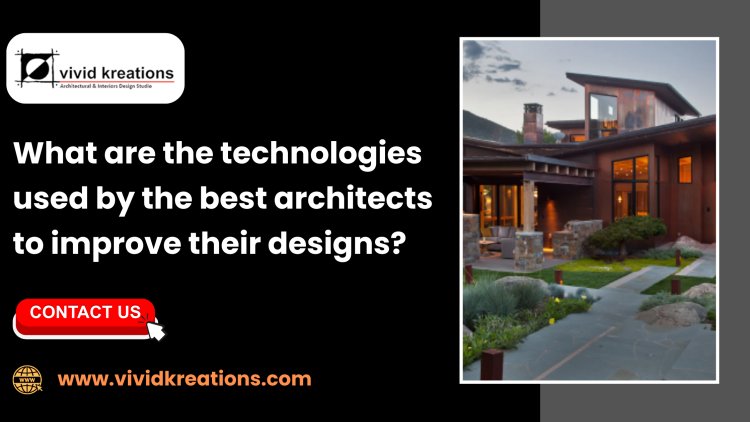What are the technologies used by the best architects to improve their designs?
Modern architecture is characterized by the integration of Innovative technologies, which has a profound effect on how architects conceive, design, and realize their visions.
Share this Post to earn Money ( Upto ₹100 per 1000 Views )

Introduction:
Modern architecture is characterized by the integration of Innovative technologies, which has a profound effect on how architects conceive, design, and realize their visions. From advanced modeling software to sustainable building materials, these technologies are redefining the capabilities of the architecture profession. This article provides a comprehensive overview of the most influential technologies shaping the best architects today.
Building Information Modeling (BIM):
At the forefront of architectural technology is Building Information Modeling (BIM). This sophisticated software allows architects to create detailed 3D models that integrate various aspects of a building’s design. Unlike traditional blueprints, BIM provides a comprehensive digital representation, incorporating structural, mechanical, and electrical components. The ability to visualize and manipulate these elements in a virtual space streamlines the design process, enhances collaboration among stakeholders, and identifies potential issues before construction begins. BIM's data-rich models also facilitate better decision-making, cost estimation, and project management, ultimately leading to more efficient and successful building projects.
Parametric Design:
Parametric design is another revolutionary technology that enables architects to create complex and adaptive structures. Through algorithms and computational design tools, architects can manipulate parameters to explore a wide range of design possibilities quickly. This approach allows for the generation of intricate forms and patterns that would be nearly impossible to achieve using traditional methods. By adjusting parameters, architects can optimize designs for performance, aesthetics, and functionality, resulting in buildings that are both innovative and efficient.
Virtual Reality (VR) and Augmented Reality (AR):
Virtual Reality (VR) and Augmented Reality (AR) are transforming how architects present and refine their designs. VR immerses clients and stakeholders in a fully virtual environment, allowing them to experience a building’s design before construction begins. This immersive experience helps in visualizing spatial relationships and design elements, making it easier to convey ideas and gather feedback. Architects can use AR to superimpose design elements onto physical spaces, offering a real-time view of how new structures will interact with their surroundings. Both VR and AR enhance communication, improve design accuracy, and facilitate more informed decision-making.
3D Printing:
3D printing is revolutionizing the construction industry by enabling the creation of intricate architectural components and even entire buildings with precision and efficiency. This technology allows for the fabrication of complex geometries that would be challenging or cost-prohibitive with traditional methods. Architects and builders can produce custom components on-site, reducing waste and allowing for rapid prototyping and iteration. As 3D printing materials and techniques continue to advance, their potential to transform architecture grows, offering new possibilities for design and construction.
Sustainable Technologies:
Sustainability is a crucial consideration in modern architecture, and several technologies are leading the way in green building practices. Solar panels, green roofs, and advanced insulation materials are just a few examples of how architects are incorporating eco-friendly technologies into their designs. Energy-efficient building systems, such as smart lighting and climate control, contribute to reduced energy consumption and lower operational costs. Moreover, architects are increasingly using simulation software to analyze the environmental impact of their designs. These tools help in optimizing energy performance, daylighting, and thermal comfort, ensuring that buildings not only meet but exceed sustainability standards.
Advanced Construction Materials:
The development of advanced construction materials is pushing the boundaries of architectural design. From self-healing concrete that repairs its own cracks to ultra-lightweight materials that reduce structural load, these innovations are enhancing both the durability and flexibility of buildings. Materials like carbon fiber and high-performance composites enable architects to create slender, more intricate structures without compromising strength. Nanotechnology is also playing a role in the evolution of building materials. For example, nanocoatings can improve the durability and self-cleaning properties of building surfaces, contributing to longer-lasting and lower-maintenance structures.
Robotics and Automation:
Robotics and automation are making significant inroads into architecture and construction. Robotic systems can perform repetitive tasks with high precision, such as bricklaying and welding, reducing labor costs and improving accuracy. Automation technologies also streamline construction processes, minimizing delays and optimizing project timelines. In addition, robots can assist in creating complex forms and structures that would be challenging to achieve manually. Their ability to work continuously and with exacting precision enhances the overall quality of construction and opens up new possibilities for architectural design.
Smart Building Technologies:
Smart building technologies are revolutionizing how buildings operate and interact with their occupants. These systems use sensors, actuators, and data analytics to monitor and control various aspects of a building’s performance. From automated lighting and climate control to advanced security systems, smart technologies contribute to a more comfortable and efficient living and working environment. The integration of Internet of Things (IoT) devices allows for real-time monitoring and management of building systems, leading to improved energy efficiency, enhanced security, and a more personalized experience for occupants. As smart technologies continue to evolve, their impact on architecture and building management will only grow.
Conclusion:
The convergence of these technologies is propelling architecture into a new era of innovation. Building Information Modeling (BIM), parametric design, Virtual and Augmented Reality (VR and AR), 3D printing, sustainable technologies, advanced materials, robotics, and smart building systems are each contributing to a more dynamic, efficient, and sustainable architectural landscape. Best architects continue to embrace these tools, and the potential for groundbreaking designs and improved building performance expands, promising a future where the built environment is more responsive to the needs of its users and the planet.
For more information:
Call: +91 9844278751
Email: shree@vividkreations.com
Website: https://www.vividkreations.com

 vividkreations
vividkreations 















